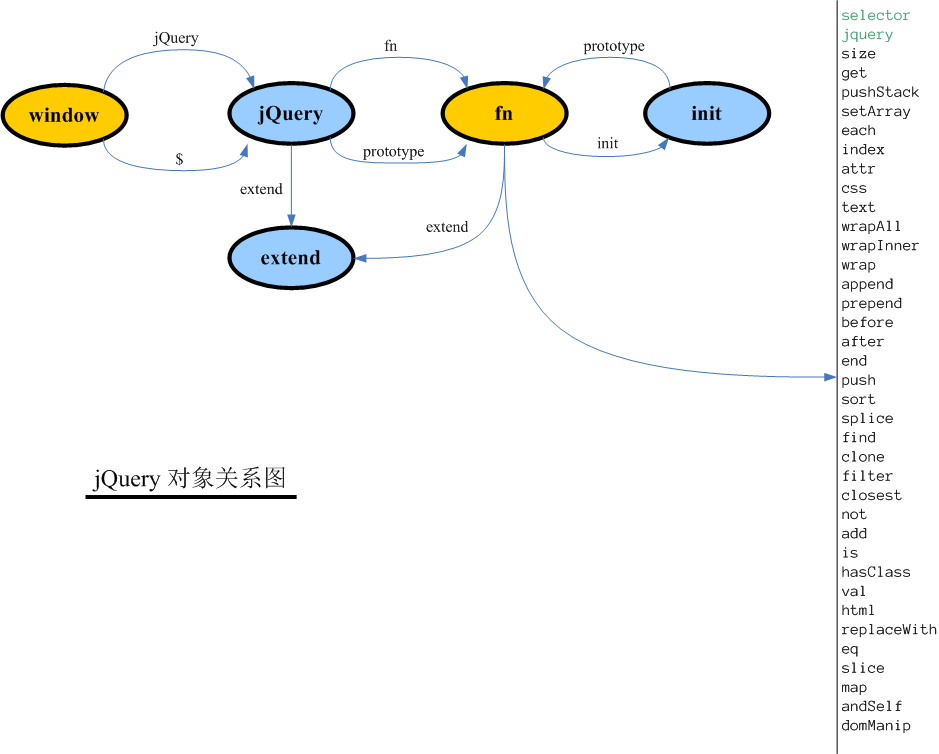jQuery的实现原理的模拟代码 -1 核心部分
核心部分实现了两种选择器,使用 id 和标记名,还可以提供 css 的设置,以及 text 的设置。
// # 表示在 jQuery 1.4.2 中对应的行数
// 定义变量 undefined 方便使用
var undefined = undefined;
// jQuery 是一个函数,其实调用 jQuery.fn.init 创建对象
var $ = jQuery = window.$ = window.jQuery // #19
= function (selector, context) {
return new jQuery.fn.init(selector, context);
};
// 用来检查是否是一个 id
idExpr = /^#([\w-]+)$/;
// 设置 jQuery 的原型对象, 用于所有 jQuery 对象共享
jQuery.fn = jQuery.prototype = { // #74
length: 0, // #190
jquery: "1.4.2", // # 187
// 这是一个示例,仅仅提供两种选择方式:id 和标记名
init: function (selector, context) { // #75
// Handle HTML strings
if (typeof selector === "string") {
// Are we dealing with HTML string or an ID?
match = idExpr.exec(selector);
// Verify a match, and that no context was specified for #id
if (match && match[1]) {
var elem = document.getElementById(match[1]);
if (elem) {
this.length = 1;
this[0] = elem;
}
}
else {
// 直接使用标记名
var nodes = document.getElementsByTagName(selector);
for (var l = nodes.length, j = 0; j < l; j++) {
this[j] = nodes[j];
}
this.length = nodes.length;
}
this.context = document;
this.selector = selector;
return this;
}
},
// 代表的 DOM 对象的个数
size: function () { // #193
return this.length;
},
// 用来设置 css 样式
css: function (name, value) { // #4564
this.each(
function (name, value) {
this.style[name] = value;
},
arguments // 实际的参数以数组的形式传递
);
return this;
},
// 用来设置文本内容
text: function (val) { // #3995
if (val) {
this.each(function () {
this.innerHTML = val;
},
arguments // 实际的参数以数组的形式传递
)
}
return this;
},
// 用来对所有的 DOM 对象进行操作
// callback 自定义的回调函数
// args 自定义的参数
each: function (callback, args) { // #244
return jQuery.each(this, callback, args);
}
}
// init 函数的原型也就是 jQuery 的原型
jQuery.fn.init.prototype = jQuery.prototype; // #303
// 用来遍历 jQuery 对象中包含的元素
jQuery.each = function (object, callback, args) { // #550
var i = 0, length = object.length;
// 没有提供参数
if (args === undefined) {
for (var value = object[0];
i < length && callback.call(value, i, value) !== false;
value = object[++i])
{ }
}
else {
for (; i < length; ) {
if (callback.apply(object[i++], args) === false) {
break;
}
}
}
}
在 jQuery 中, jQuery 对象实际上是一个仿数组的对象,代表通过选择器得到的所有 DOM 对象的集合,它像数组一样有 length 属性,表示代表的 DOM 对象的个数,还可以通过下标进行遍历。
95 行的 jQuery.each 是 jQuery 中用来遍历这个仿数组,对其中的每个元素进行遍历处理的基本方法,callback 表示处理这个 DOM 对象的函数。通常情况下,我们并不使用这个方法,而是使用 jQuery 对象的 each 方法进行遍历。jQuery 对象的 css 和 text 方法在内部实际上使用 jQuery 对象的 each 方法对所选择的元素进行处理。
这些函数及对象的关系见:jQuery 原型关系图

下面的脚本使用这个脚本库。
// 原型操作
$("h1").text("Hello, world.").css("color", "green");